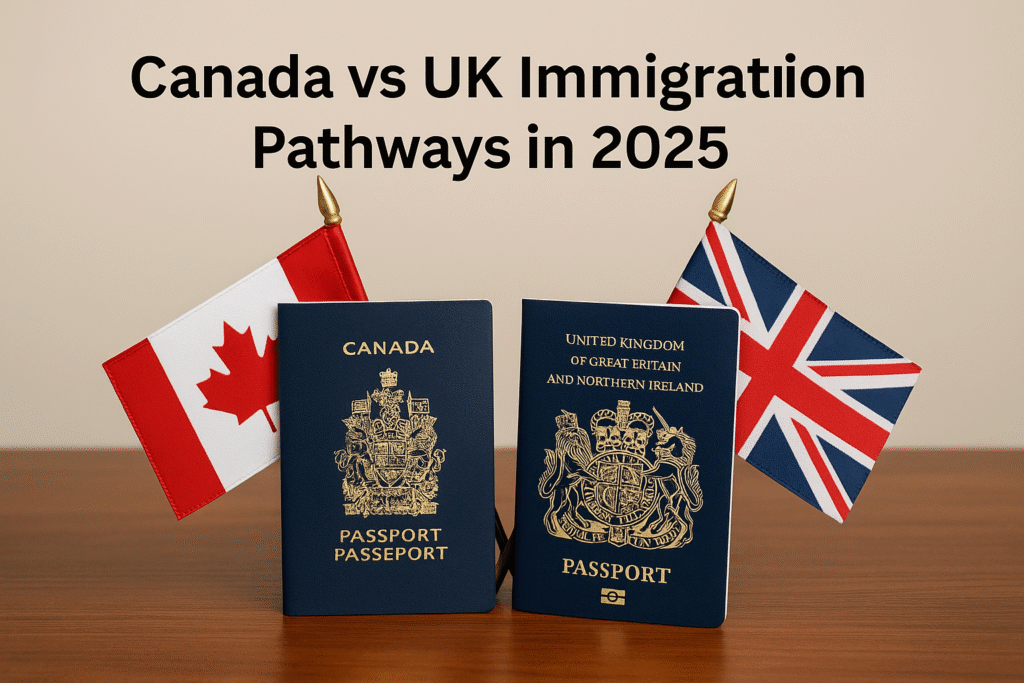
In 2025, international migration remains at the heart of global mobility, with millions of people exploring opportunities abroad. For Nigerians and other international applicants, Canada and the United Kingdom stand out as two of the most attractive destinations.
But which country offers the better immigration pathway in 2025? The answer depends on your goals — whether you want permanent residency, global work experience, world-class education, or a stepping stone to citizenship.
As someone who explored both Canada and the UK immigration pathways, the difference was clear. When I applied for Canada’s Express Entry system, the points-based CRS made the process transparent. I knew exactly where I stood and how improving my IELTS score could boost my ranking. On the other hand, when I explored the UK Skilled Worker Visa, I realized I was heavily dependent on securing a job offer from a licensed sponsor. For me, Canada felt more like a system where I had control, while the UK’s process felt employer-driven. In the end, my decision leaned toward Canada, not just for the PR clarity but also because of the strong Nigerian community in Toronto and Calgary.
This article breaks down both Canada’s immigration system and the UK’s visa routes, compares the advantages and disadvantages, and highlights practical tips for applicants.
Canada Immigration Pathways in 2025
Canada has built a global reputation for its welcoming policies and clear pathway to permanent residency (PR).
1. Express Entry System
The flagship program for skilled workers:
- Managed under Express Entry.
- Three streams: Federal Skilled Worker (FSW), Federal Skilled Trades (FST), Canadian Experience Class (CEC).
- Points-based Comprehensive Ranking System (CRS).
- Applicants with the highest CRS scores receive Invitations to Apply (ITA).
2. Provincial Nominee Programs (PNPs)
- Each province (Ontario, British Columbia, Alberta, etc.) has unique immigration streams.
- Candidates nominated by provinces gain extra CRS points, boosting their PR chances.
- Source: Provincial Nominee Programs.
3. Student Pathway
- International students can study in Canada under a Study Permit.
- Eligible for Post-Graduation Work Permits (PGWP) and later apply for PR.
4. Family Sponsorship
- Canadian citizens/PR holders can sponsor spouses, partners, and dependents.
- Source: Family Sponsorship.
5. Business & Investor Streams
- Options like the Start-Up Visa Program for entrepreneurs.
- Provincial entrepreneur programs also exist (e.g., BC, Ontario).
Advantages of Canada’s Pathway:
- Clearer route to PR and citizenship.
- Healthcare and education benefits are available upon PR.
- Lower visa refusal rate compared to the UK.
Challenges:
- Competitive CRS scores required.
- Long processing times (6–12 months+).
- Cold climate may deter some.
🇬🇧 UK Immigration Pathways in 2025
The UK offers diverse visa routes, but permanent residency (Indefinite Leave to Remain, or ILR) usually takes longer compared to Canada.
1. Skilled Worker Visa
- Replaced Tier 2 (General) Visa.
- Requires job offer from a licensed UK sponsor.
- Minimum salary thresholds apply (reduced for shortage occupations).
2. Global Talent Visa
- Designed for leaders or potential leaders in fields like tech, research, and the arts.
- Source: Global Talent Visa.
3. Innovator Founder Visa (2025 Update)
- Replaced Tier 1 Entrepreneur.
- Requires endorsement for an innovative, viable, and scalable business idea.
- Source: Innovator Founder Visa.
4. Health and Care Worker Visa
- Attracts international medical professionals.
- Reduced fees and faster processing.
- Source: Health and Care Visa.
5. Student Route
- International students can apply via the Student Visa.
- Eligible for the Graduate Route (2–3 years post-study work).
Advantages of the UK’s Pathway:
- Access to world-class universities.
- London is a financial and cultural hub.
- Easier entry for students and workers compared to Canada.
Challenges:
- Stricter PR rules; ILR typically after 5 years.
- High cost of living in cities like London.
- Immigration policies are subject to frequent changes.
Canada vs UK Immigration: Key Comparison Table
| Feature | Canada | UK |
|---|---|---|
| PR Pathway | Direct via Express Entry, PNP | Usually after 5+ years (ILR) |
| Processing Time | 6–12 months (Express Entry) | 3–6 months (Skilled Worker) |
| Dependents Included | Yes (spouse & children) | Yes (spouse & children) |
| Healthcare | Free under PR | NHS access with surcharge |
| Education Benefits | Subsidized for PR | International fees until PR/ILR |
| Job Offer Requirement | Not mandatory for Express Entry | Mandatory for most visas |
| Citizenship Timeline | 3 years after PR | 1 year after ILR (6+ years total) |
| Cost of Living | Moderate–High (Toronto, Vancouver) | High (London, Manchester) |
Helpful External Resources
- Canada Immigration:
- UK Immigration:
- Skilled Worker Visa
- Global TalCanada vs UK Immigration Pathways in 2025ent Visa
- Innovator Founder Visa
- Student Visa
Final Thoughts
Both Canada and the UK offer strong immigration pathways in 2025, but the right choice depends on your goals:
- If you want permanent residency and eventual citizenship, Canada is often the better choice thanks to its transparent Express Entry and PNP system.
- If you’re focused on short-term work opportunities, global exposure, and studying at elite universities, the UK provides excellent options — though PR takes longer.
👉 Whether you’re from Nigeria, India, or anywhere else, the key is preparation: research each route carefully, check the latest government updates, and choose the country that aligns with your long-term vision.